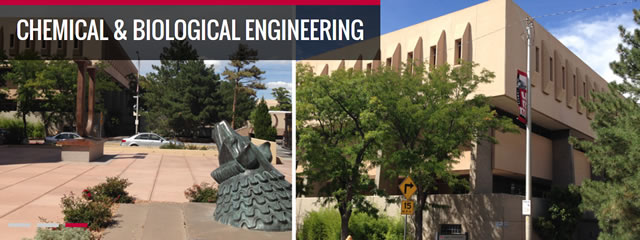
Chemical and Biological Engineering ETDs
Publication Date
Summer 7-15-2017
Abstract
Fuel cells are considered to be one the most promising sustainable energy technologies for energy conversion and electric power generation. With the development of stable, conductive and high performance anion exchange membranes and ionomers, there has been an increased interest towards studying various electrochemical reactions in Anion Exchange Membrane Fuel Cells (AEMFC). This increased attention has been attributed to the comparatively facile reaction kinetics, minimized corrosion effects and reduced fuel crossover in alkaline media. However, the oxygen reduction reactions (ORR) taking place in the cathode compartment of fuel cells plays a crucial role in optimizing the electrochemical energy conversion efficiency, which is why it’s imperative to design electrocatalysts that can efficiently catalyze the electroreduction of oxygen in alkaline media.
Various studies have demonstrated the improved intrinsic activity, stability and accessibility of Palladium/Graphene-based nanocomposites for ORR in alkaline electrolytes, although their integration into operating AEMFCs have been quite limited to date. This is mainly due to the challenges associated with (i) synthesizing Pd nanoparticles without surfactants and organic stabilizers (ii) fabricating porous graphitized supports with controlled morphologies that can form triple phase boundaries and (iii) a lack of standardization and optimization for integrating these nanocomposite materials into the membrane electrode assemblies of AEMFCs.
This work addresses the current limitations and technical challenges by providing a synthetic strategy for designing Pd/Graphene nanocomposites with i) controlled surface to volume ratios for enhancing the solid-liquid-gas phase boundaries, ii) modified chemical properties for improving nanoparticle dispersion and electrochemical accessibility and iii) targeted tuning of active sites through nitrogen functionalization for oxygen electroreduction in alkaline media. In particular, stable size-controlled Pd nanoparticles were synthesized using surfactant free technique and deposited on hierarchically structured nitrogen doped 3D-Graphene nanosheets that were fabricated with varying levels of micro-, and macro-porosities developed using a sacrificial templating and pyrolytic methods. Using a synergetic combination of potentiodynamic, surface analysis and spectroscopic techniques, it was demonstrated that the porosity, surface functionalization, and the nature of nitrogen moieties doped into played a significant role in in modifying the size, dispersion, electrochemical accessibility as well as activity of the Pd nanoparticles for oxygen electroreduction in alkaline media. The Pd/3D-Graphene composite materials were also integrated into a catalyst coated membrane, optimized (assembly, activation, electrode fabrication) and analyzed for their performance in H2/O2 fed AEMFCs operating at 60°C. It was demonstrated that conditioning of the membranes was crucial for reducing ohmic losses, whereas porosity of the supports was imperative for facilitating mass transport kinetics.
Overall, this work analyzes how the morphological and chemical properties of graphitized supports can be modified to play a key role in improving oxygen electroreduction pathways not only in the alkaline electrolytes, but also in minimizing concentration polarization losses in operating AEMFCs. The results in this study further highlights the importance of rationally designing nanomaterials for high-performance energy conversion devices, and can also be expanded to other energy storage and conversion applications such as electrodes for Li-air batteries and electrolyzers.
Keywords
Electrocatalysts, Fuel Cell, Oxygen Electroreduction, Palladium, 3D-Graphene
Document Type
Dissertation
Language
English
Degree Name
Chemical Engineering
Level of Degree
Doctoral
Department Name
Chemical and Biological Engineering
First Committee Member (Chair)
Plamen Atanassov
Second Committee Member
Alexey Serov
Third Committee Member
Dr. Fernando Garzon
Fourth Committee Member
Dr. Kateryna Artyushkova
Fifth Committee Member
Dr. Vijay Ramani
Recommended Citation
Kabir, Sadia Afrin. "Designing Nanocomposite Materials For Catalyzing Electrochemical Reactions in Anion Exchange Membrane Fuel Cells." (2017). https://digitalrepository.unm.edu/cbe_etds/67
